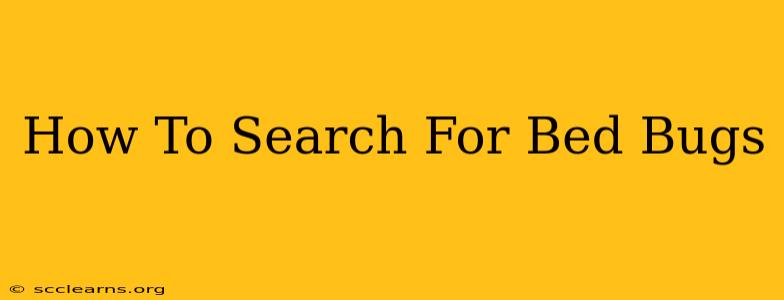Bed bugs. Just the word sends shivers down many spines. These tiny, nocturnal pests are notorious for their itchy bites and the difficulty in eradicating them. Knowing how to effectively search for bed bugs is the first crucial step in controlling an infestation. This comprehensive guide will equip you with the knowledge and techniques to thoroughly inspect your home and identify these unwelcome guests.
Understanding Bed Bug Behavior: Where to Look First
Before you start your search, understanding bed bug behavior is key. They are masters of hiding, preferring dark, secluded areas close to their food source: you! They don't just live in beds.
Prime Locations for Bed Bugs:
- Mattress and Box Spring: Start here! Carefully inspect seams, crevices, and tufts. Use a flashlight to illuminate hidden areas. Look for dark spots (fecal matter), small blood stains, and the bugs themselves (they're about the size of an apple seed).
- Headboard: Check behind and underneath the headboard, paying close attention to any gaps or cracks.
- Bed Frame: Inspect the bed frame meticulously, including the joints and any areas where the frame meets the wall.
- Nightstands and Dressers: Bed bugs can easily travel to nearby furniture. Check drawers, crevices, and the surfaces themselves.
- Baseboards and Walls: Look for signs of bed bugs along baseboards, particularly near the bed.
- Electrical Outlets: These small spaces can provide ideal hiding places.
- Pictures and Wall Hangings: Check behind pictures and wall hangings.
- Clothing and Luggage: If you suspect you've encountered bed bugs while traveling, immediately inspect your luggage and any clothing you wore.
Tools for a Thorough Bed Bug Inspection:
A thorough inspection requires more than just your eyes. These tools will greatly assist your search:
- Flashlight: A strong flashlight is crucial for illuminating dark crevices.
- Magnifying Glass: A magnifying glass will help you spot tiny bed bugs, eggs, and fecal matter.
- Screwdriver: You may need a screwdriver to remove outlet covers or access other tight spaces.
- Dusting Brush: A small dusting brush can help you dislodge bed bugs from crevices and cracks for better visibility.
Identifying Signs of a Bed Bug Infestation:
Beyond seeing the bugs themselves, there are other telltale signs to look for:
- Bite Marks: Bed bug bites often appear in a line or cluster. They are usually red, itchy, and raised.
- Fecal Spots: These are tiny, dark spots that resemble ink.
- Eggs: Bed bug eggs are tiny, pearly white, and difficult to spot without magnification.
- Shedding Skins: As bed bugs grow, they shed their skin, which can be found near their nesting sites.
- A Musty Odor: In severe infestations, a musty odor may be present.
What to Do if You Find Bed Bugs:
Finding bed bugs is unsettling, but it's important to remain calm and act decisively. Do not attempt to treat a large infestation yourself. Professional pest control is almost always necessary for effective eradication.
Here's what you should do:
- Document the infestation: Take photos or videos of the bed bugs and their location.
- Contact a pest control professional: A qualified professional will accurately assess the infestation and develop a treatment plan.
- Isolate the infested area: If possible, isolate the infested area to prevent the spread of bed bugs.
- Wash and dry all bedding and clothing: Wash all bedding, clothing, and other fabrics in hot water and dry them on high heat to kill any bed bugs or eggs.
By following these steps and using the tools and tips provided, you can effectively search for bed bugs and take the necessary steps to eliminate them. Remember, early detection is key to successful treatment. Don't hesitate to seek professional help if you suspect an infestation. Early intervention saves you time, money, and a lot of stress!

